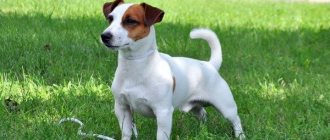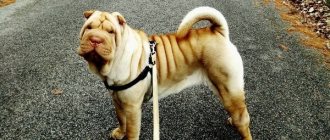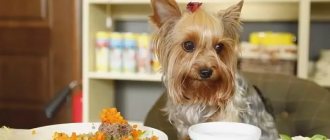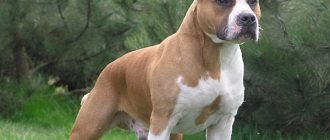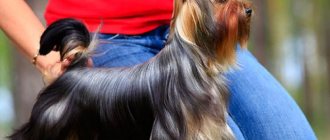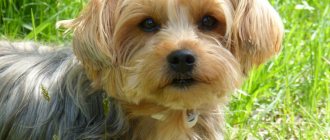The Yorkshire Terrier is a miniature dog that looks like a toy. At the same time, the dog is energetic, active, and almost never sits still. Many owners do not believe that they need to be trained, trained and exercised. Due to lack of education, Yorkshire terriers grow up disobedient, uncontrollable and make life difficult for themselves and their owner. To avoid unmotivated behavior of the Yerk, you need to start training him as early as possible, taking into account the characteristics of the breed and the individuality of each dog.
Features of raising a Yorkshire Terrier
Like most terriers, the Yorkshire's character is not entirely simple. Although they are loyal to their owner, they can behave inappropriately. When they are not trained, the erk tries to become the “leader of the pack” and shows aggression towards surrounding animals and people.
At the same time, Yorkies are smart, cunning, curious, playful and affectionate towards children. Only correct and regular training, perseverance, and systematic training make it possible to raise a puppy into a wonderful friend and companion. Raising and training Yorkies is not difficult, but you should take into account the physical capabilities, character and gender of each.
Girls
Yorkie girls are more good-natured, affectionate and obedient than boys. At the same time, they are brave, but cautious. Females become more attached to their owner and are easier to educate and train. However, there are also girls with quarrelsome characters and disgusting behavior. Most often, such a Yorkshire terrier was raised incorrectly and the puppy’s character was not corrected in a timely manner. The most problematic time in a bitch's life is estrus and pregnancy. At this moment, you need to treat her with care, but not allow “liberties” in behavior.
Boys
Raising Yorkie males is more difficult. They are distinguished by great mobility and playfulness. Behavior is largely determined by nature. Therefore, they mark the territory for which they can choose an apartment, its walls and furniture. The owner’s task is to raise the Yorkie so that he does this not in the house, but on the street, in the yard. Yorkshire Terrier boys are more independent, cocky and stubborn. It is necessary to cultivate in them discipline and restraint, an understanding of what can be done and what absolutely cannot be done.
Interesting Facts
- The origin of the breed is not known with certainty. Here are some possible parents: Clydesdale Terrier, Dandie Dinmont Terrier, Leeds Terrier, Maltese Terrier, Manchester Terrier, Paisley Terrier, Skye Terrier, Waterside Terrier.
- The word "terrier" refers to a small and feisty dog that was once used to work underground and hunt in small, inaccessible places.
- There are many famous Yorkie owners. For example, Audrey Hepburn, Joan Rivers, Missy Elliott, Natalie Portman, Paris Hilton and Simon Cowell.
- York, named Famous, played in the movie Funny Face with Audrey Hepburn.
- A York named Pasha, owned by First Lady Tricia Nixon, once lived in the White House.
- Huddersfield Ben is the most famous Yorkshire Terrier. The dog was named after the city in which he was born. This dog belonged to a man named M. A. Foster. Huddersfield Ben has become very famous after winning over 70 shows and countless competitions.
- Thanks to the long hair, you can come up with various beautiful hairstyles for your pets. For an uncut pet, you can tie the hair in a ponytail or braid it.
Are Yorkies trainable?
Raising a dog normally is not difficult. Even a small Yorkshire Terrier understands perfectly well what is required of him. The owner must become a leader for his pet, despite the fact that the puppy always strives for dominance. The training process is carried out in a playful way. Yorkies do not like monotony and coercion. Education is carried out constantly, from the first day the dog appears in a new home, patiently teaching it its name, order, place, rules of behavior in the apartment and on the street.
History of the breed
The age of the breed is about 150 years. Yorkshire dogs were bred in England, in the counties of Yorkshire and Lancashire, to guard fields. In those days, peasants were forbidden to keep large dogs, and small terriers were excellent in dealing with rodents and often accompanied their owners on trading trips.
It is believed that the first representatives of the breed appeared from crossing Scottish, Manchester terriers and Maltese dogs. From the first Yorkies they inherited courage, perseverance, and boundless devotion to their owner. And from the lap dogs they got luxurious wool, which became the calling card of the breed.
The British joke that the Scottish weavers were so proud of their little nimble helpers, from whom not a single rat could escape, that they made such beautiful, silky hair for them.
pixabay.com/
The breed was recognized at the end of the 19th century, and its first club appeared, of course, in Great Britain. Yorkies came to Russia almost 100 years later, in 1971. The first representative of the breed in our country became the pet of the ballerina Olga Lepeshinskaya , and the first nursery in the Moscow region appeared only in the early 90s.
Since then, Yorkshire terriers have ceased to be “outlandish” and exotic dogs and have gained popularity as representatives of one of the smallest breeds, ideal for keeping in an apartment.
Why do you need to train Yorkies?
Raising and training a Yorkshire Terrier helps to avoid the creation of unwanted situations. Gradually, the puppy understands how to behave and ceases to be uncontrollable. You can expect everything from an ill-mannered Yorkie - barking at others, aggression. They can pick up food from the ground, bite, and jump on their owners’ beds and tables. The dog is capable of running away, getting hit by a car and getting injured. Education, training and teaching basic commands help make a dog's behavior predictable and his life safe.
At what age should you start training and raising a puppy?
Already at the age of one month it is necessary to raise a Yorkshire Terrier. Most often, the breeder teaches him the first skills, since puppies are sold no earlier than two months.
Training is carried out according to plan:
- At the age of 1-2 months, they are accustomed to a nickname, a toilet, and the commands “Come to me!” and “Place!”
- At 3 months, raising a puppy consists of developing the skill of wearing a collar, walking on a leash, and following the commands “Sit!”, “No!”.
- At 4-5 months they practice the commands “Near!” and “Lie down!”
- At 6-8 months, they repeat previously acquired skills and carry out the orders “Bring it!”, “Fu!”, “Give me a paw!”
- From 8 months to a year, the Yorkshire Terrier is actively socialized and reinforced what has been learned.
Rules for training at home
When raising and training a Yorkshire Terrier, you should adhere to several rules:
- Yorkie training begins as early as possible.
- To teach a puppy new things, move from simple to complex.
- At the initial stage, it is better to train the Yorkshire Terrier at home so that the dog is not distracted by anything during training.
- During one training period, you need to teach the Erka to carry out a single command.
- In the process of education they show persistence in order to achieve results.
- When addressing a yorik, they always call him by his name.
- The tone of communication should be calm and friendly.
- For training, choose a moment when both the owner and the Yorkshire Terrier are in a good mood.
Dog won't accept new pet
York gets along well with all members of the household, provided that he grew up with them and has known them since childhood. If you decide to bring another pet into your home, be prepared for an aggressive reaction. The dog will begin to openly show his hostility towards the new neighbor, be jealous of the owner and
We are waiting for the opportunity to provoke a fight. The owner must show considerable patience in order to calm the dog down and make it clear that now he is not alone in the house.
Duration of classes
Long-term exercise is tiring for Yorkshire Terriers. They get tired quickly, lose interest and attention. Start with 5 minutes, gradually increasing the time of training and education to 15 minutes. To consolidate the acquired skills, training is repeated several times a day. Between classes they take a break, during which they play with Erik or take him outside for a walk.
Appearance
— Advertising —
The Yorkshire Terrier is a tiny dog. The normal weight of an adult is 1.81-3.17 kilograms. These are not tall animals: they grow up to 23 centimeters. Despite its tiny size, the dog loves speed.
The American Kennel Club prescribes the following parameters for the breed: a smooth-haired toy terrier, with a compact and well-proportioned body. The dog's high head and self-confidence gives it an energetic and proud appearance.
The head is miniature, flat on top. The skull is not convex, the muzzle is not too elongated. Scissor bite.
— Advertising —
The nose is black and wet.
The eyes are medium in size, not protruding. They are dark in color and intelligent. The rims of the eyes are dark.
The ears are small, V-shaped, stand vertically, and are located not far from each other.
The body is well built and compact. The back is short and level.
The front and rear legs are straight. When viewed from behind, the knees are slightly bent. Paws are round, with black nails. The tail is docked.
The quality, texture and quantity of wool are of great importance. The hairs are silky and thin. The body coat is moderately long and straight.
Several colors of the breed are recognized:
- Black and gold.
- Black and beige.
- Blue and beige.
- Blue and gold.
- Silver or ash and beige.
- A mixture of black, white and brown colors.
Training a Yorkie puppy: where to start?
For training to bear fruit, the owner of the Yorkshire Terrier must know what result he is striving for. Before you teach your puppy basic commands, you need to raise him correctly. Yorshiki must be clean, not jump on the owner’s chest even for joy, not spoil shoes, furniture and other items, and follow a daily routine. During the upbringing, the child is taught a nickname, a toilet at home and on the street, his place, correct behavior when walking and in public transport, and communication with people and animals.
Remembering your nickname
Education is more successful if you teach Erik to respond to his nickname as early as possible. This is done immediately after he arrives in his new home. Choose a short, sonorous name and pronounce it in a gentle tone at any opportunity. As soon as the puppy responds to the call and approaches, he is praised and treated with a treat. There should be only one nickname, it should not be modified or pronounced in different ways, otherwise the dog will get confused and forget his name. In order not to develop a negative attitude towards his name in the Yorkshire Terrier, dog handlers do not recommend calling it when scolded for an offense.
Tray and diaper training
Raising a Yorkshire Terrier is incomplete without toilet training. While the puppy is small, he can go to the tray, on a diaper or newspaper. The floor in the room is covered with them. At first, the Yorkie goes about his business wherever he needs to. Gradually, the number of diapers and newspapers is reduced, eventually leaving only one in the place where the toilet will be.
If, during training, Erik made a puddle in the wrong place, you should not shout at him or poke his nose. This kind of “education” has the opposite effect. The puppy begins to hide in secluded places and go to the toilet there.
When trouble occurs, you need to blot the puddle with a diaper, put the cloth in the tray and take the Yorkshire Terrier there. The process of education and training to maintain cleanliness is long and requires perseverance and patience.
Toilet training outdoors
After vaccination and quarantine are completed, the Yorkshire Terrier puppy begins to be taken for a walk. At this time, he is trained to use the toilet outside, which is quite difficult to do. The baby is already accustomed to the tray, so he endures it and runs home to the container or diaper.
The dog is taken out for a walk immediately after feeding or sleeping at night. They take with them the diaper that she has already worn. They give it a sniff and lay it on the ground. If she relieves herself, she is praised. At first you will have to walk up to 7 times a day. After the Yorkie becomes an adult, two or three walks per day are enough.
Accustoming to a place in the apartment
The Yorkshire Terrier should have its own place in the house where it sleeps, rests and eats. To teach a Yorkie to order, he is first transferred to a bedding as soon as he falls asleep, not allowing him to remain on the sofa, bed or chair. The puppy is given a lot of toys so that he does not chew everything around him. Even if the dog has ruined something, you should not shout or get angry at him; further education will help correct the baby’s behavior.
Correct behavior on the street
Many owners of Yorkshire Terriers often carry their pets in their arms on the street and in public places. Despite this, they need to be taught to behave correctly, be able to walk on a leash, and stop when ordered by the owner. Raising Yorkies should be aimed at learning the rules of behavior - do not bark at others, do not run away from the owner, do not pick up food from the ground. Socialization is carried out gradually - first in the house, then at the dog park, and later in public places.
Kinds
Dog breeders have bred several varieties of Yorkies.
Mini
Most people are very familiar with Yorkshire Terriers. However, not everyone knows about mini (dwarf) Yorkies. Basically, they are the same dog and breed in every way. The only difference is the size and weight of about 2 kilograms.
If you decide to acquire such a friend, pay attention to the following:
- Pets need to be constantly monitored. Due to their small size, they can easily fall off a chair, sofa or other furniture.
- If there are small children in the family, this dog is not the best choice. Kids may not calculate their strength and torture such a pet.
- You should not take on breeding a Mini Yorkie unless you are an expert.
- They live shorter lives than their brothers.
- This is a hypoallergenic dog.
Beaver
This type of breed was first registered by German breeders in the 80s.
The main difference between the Biewer Yorkshire Terrier and the standard one is the color of its coat. Individuals have a black-and-white or gray-white color, with golden veins on the muzzle.
A big plus of this species is the health of the skeletal system. It has been proven that such animals have a fairly strong musculoskeletal system.
Biro-Yorks and Shoko-Yorks
Biro Yorkies also differ in the color of their coat. Individuals do not have black hairs. The main color of the breed is chocolate, with a shade called golden.
There is a slight difference in size: Biro-Yorks are slightly larger than the standard.
More recently, another subtype of the breed was created, namely the Choco-Yorkie. Their body color is exclusively chocolate.
Baby
Baby Yorkie is a species similar to an ordinary pet. The main difference between the subspecies is the non-standard muzzle.
The features are as follows:
- The head is round.
- The muzzle is shorter than that of traditional animals.
- The ears are located below the level of the forehead.
- The eyes are large and protruding.
Because of these characteristics, his face appears cute and resembles the facial expression of a baby doll. Hence the name - baby face.
What commands should you teach your Yorkshire Terrier?
Raising, training and teaching commands of a Yorkshire Terrier must be built in a game format that is interesting for the pet. We should not forget about encouragement in the form of treats and affectionate words. The tone of communication should be calm and friendly. At the same time, commands are given to Yorkshire terriers clearly and loudly. They are not repeated several times, no unnecessary words are added, and they are pronounced in the same form. If the dog follows the order, he is rewarded.
To properly raise a puppy, it is worth enrolling in training courses. Experienced dog handlers will not only give advice on home education, but also teach the main commands.
"Sit!"
The training of obedience in Yorshiks begins with the command “Sit!” The dog must be taught to do this for up to three months, since it must be able to wait in place until it is allowed to move on.
To practice the command “Sit!” operate according to the following scheme:
- Call the pet by name.
- They say “Sit!” and press on the sacrum while holding the treat above your head.
- They hold him in this position and then give him a treat.
- Repeat several times.
"Lie!"
After the Yorshik learns the command “Sit!”, proceed to the next one – “Lie down!”. Developing this skill allows you to calmly examine the dog, cut it or carry out hygiene measures. The training is simple. First, the dog is given the command “Sit!”, after which he is shown a treat in his hand and lowered to the floor. At the same time they say: “Lie down!” As soon as the Yorkie lies down, they give him a treat and praise him. You can help the dog by pressing on the back.
"Place!"
From the first day a Yorkshire Terrier arrives in the house, they are taught the command “Place!” Developing the habit of order begins with getting to know the dog’s resting place. The bed should be cozy and comfortable; you can put your puppy’s toys there.
To accustom the pet to the command, they bring it to its bedding and say: “Place!” If the dog comes, they give him a treat. Through repetition, they achieve the fulfillment of orders and cultivate unquestioning obedience.
"To me!"
To develop correct behavior on the street, the Yorkshire Terrier is taught the command “Come to me!” This skill is extremely important if the dog walks without a leash. The command is pronounced at the moment when he is called to eat. You need to train regularly so that the execution of orders becomes automatic. The puppy is shown a treat and said: “Come to me!” As soon as he runs up, they give him a treat and praise him.
You shouldn’t scold your Yorkie if he gets stubborn and doesn’t come right away. The pet is trained and educated until a positive result is achieved.
"Near!"
All owners of Yorkshire terriers who prefer to spend a lot of time outside with their dog must definitely teach it to carry out the “Near!” command. Develop obedience and train with the help of a leash. Saying “Near!”, they tighten the harness so that the dog walks near the owner’s leg. Over time they try to change the pace, and the Yorkshireman must adjust and adapt. To prevent the dog from getting injured during the process of raising and training, you should not pull the leash too hard.
"Ugh!"
Train your Yorkshire Terrier to follow the command “Fu!” very important. Training is done on the street. As soon as the dog sees the prohibited object and reaches for it, they pull the leash and pronounce the command. When the dog gets used to following orders while on a leash, try doing it without it. Training is considered successful, and the command is learned, if the dog responds to it the first time and without outside influence.
"It is forbidden!"
Command "No!" is similar to the order “Fu!”, but it is used anywhere when it is necessary to prohibit an unwanted action - barking, aggressive behavior. Raising obedience to the command “No!” Helps prevent common dangerous situations on the road and in public places.
When a Yorkshire Terrier does something forbidden, they tug on the leash or clap their hands and command: “You can’t!” They are trained to the point of complete obedience, since only in this case can the life of a small dog be maximally protected.
“Give me your paw!”
Although dog handlers consider the command “Give me your paw!” absolutely useless, breeders teach it during the training of their pet. A trained Yorkshire Terrier that follows this command will find it easier to wash its paws, trim its nails and trim the hair between its toes. If your Yorkie is smart, it's easy to teach him. To do this, you need to sit the dog down and, calling it by name, say: “Give me your paw!” At the same time, they show a treat in their palm and take its paw in their hand. After several repetitions and treats, the dog begins to carry out the order clearly and accurately.
“Bring it!”
The Yorkshire Terrier can be taught the command “Fetch!” This skill has no practical value, but as part of education, training leads to closer contact between the dog and the owner. The dog can bring newspapers, slippers and a toy. Training the skill is quite difficult; it is not easy for Yorkies to understand what they want from them. They educate and train during the game - they throw a toy, and then bring the dog and say: “Bring it!”
Diseases
With proper care and nutrition, your pet will rarely get sick. If your baby gets sick, it is better to contact a specialist.
Below are some Yorkshire Terrier diseases that you need to know about.
- Congenital portosystemic shunt. Portosystemic shunt is also known as liver bypass. This is a problem that Yorkies are genetically predisposed to. Congenital portosystemic shunts occur in slightly less than 0.2% of all purebred dogs. Defects in the development of veins cause abnormal blood flow. Some of the blood flows around the liver, not through it. Consequently, the liver cannot completely eliminate toxins. This results in stunted growth, seizures and behavioral problems. In some cases, the problem can be treated with diet and medication, while in others it requires surgery.
- Cushing's disease. Yorkshire Terriers have a high predisposition to Cushing's disease. It is caused by an overreactive adrenal gland that produces too many steroid hormones. Symptoms of Cushing's disease include excessive urination, increased appetite, decreased activity, thin skin, and hair loss. Treatment is carried out with medication, under the close supervision of a specialist.
- Heart problems. Heart failure is the leading cause of death in older Yorkshire terriers. Two conditions they are prone to are patent ductus arteriosus and mitral valve disease. Signs: the dog is breathing heavily, wheezing, choking, coughing, has shortness of breath, gets tired quickly. Dogs with these problems have a specific type of heart murmur. They can be eliminated with surgery.
- Hypoglycemia. All small dogs are prone to hypoglycemia. This condition can be fatal if not recognized and treated. To avoid a sharp drop in blood sugar levels, you need to feed small dogs more often than large breeds. This is especially true for the first few months of life. A dog with such an illness often shakes and trembles. Contact your veterinarian if you notice any of these signs in your pet.
- Legg-Calvé-Perthes disease. This is a hip problem that occurs in small breed dogs. The symptoms are caused by spontaneous degeneration of the femoral head. This is the long bone of the leg that is located in the femur area and allows for smooth rotation of their leg. The problem is treated surgically.
- Hemorrhagic gastroenteritis. This is an acute and serious illness that can lead to death. Symptoms include bloody diarrhea, vomiting, decreased appetite, lethargy, constipation and fever. Sometimes the dog just gets sick. Diagnosis by a veterinarian may require extensive testing. Treatment includes intravenous fluids, potassium, and electrolytes. In severe cases, your doctor may prescribe antibiotics.
- Other problems. Yorkies, like many dogs, are susceptible to minor health problems. Such as, for example, dental diseases and skin allergies. Brushing your dog's teeth will help prevent dental disease. Dogs can have allergies just like humans. Signs of an allergy: the pet is constantly licking its lips, scratching its face, coughing, sneezing, and watery eyes. Contact your veterinarian who can help identify the cause and prescribe treatment.
How to properly punish and reward a Yorkshire Terrier?
In order for the education of a Yorkie to produce results, a system of rewards and punishments is used. For correctly following orders, they praise him, give him a treat, and stroke his fur. Reward should follow immediately after the action or command performed.
It is difficult to educate without punishment. If a Yorkshire terrier behaves undesirably, they do not shout at him, much less hit him. For the dog to understand his mistake, it is enough to change the tone, make it tougher and more serious. When a Yorkie does not understand what they want from him, refusal to communicate is used as punishment.
How to stop biting and barking?
Sometimes Yorkies bite their owner's fingers or grab their legs while playing. As soon as this happened, the dog was strictly commanded “No!” and stop the game. If a dog shows aggression on the street towards passers-by, they are brought up more strictly - they take it by the scruff of the neck, press it to the ground and say: “You can’t!”
Yorkshires often annoy everyone around them with their unreasonable barking. To stop a dog from yapping for no reason, distract it with a toy, splash water on it, or clap your hands.
To prevent the Yorkie from barking when he is alone, training is carried out differently. The owner leaves the apartment and does not return until the dog calms down.
How to stop chewing furniture and things?
In the process of raising a dog, it is necessary to wean it from gnawing everything that comes into its teeth. It is worth buying a Yorshik many different toys in the form of bones and balls. You can’t give old slippers or a T-shirt to be torn to pieces. If you catch your pet damaging things, you need to punish him immediately so that he understands why.
Usually after a year the Yorkshire Terrier stops chewing things. But this only happens if he was raised correctly.
Color variations
The color of the standard Yorkshire is two-tone - steel gray with reddish fawn. At the same time, the head and neck to the withers have a rich reddish-brownish tint, the chest and paws are golden with an ashen coating, and the body, tail and limbs are painted in a steel-gray color.
But there are many more color varieties of the Yorkshire Terrier, among which are the following:
- beavers;
- biro;
- Golddusts;
- chocolate;
- monochrome black and white.
There are also crosses of Yorkies with other dog breeds - representatives of designer breeds. Read about them here.
Errors in parenting
Often, inexperienced dog breeders make serious mistakes when raising an Erka:
- They behave inconsistently and do not show proper persistence.
- They talk to the pet as if it were a person, instead of giving commands clearly and briefly.
- Classes are taking longer.
- They praise or punish not immediately after the act, but after some time.
- They do not take into account the individual characteristics of the puppy.
- Stop classes after completing the training course.
- They punish physically.
How much do classes with a dog trainer cost?
Raising a Yorshik is difficult for a novice dog breeder. The best option is to seek help from an experienced dog handler. A professional will teach the puppy how to follow commands, and the owner how to properly interact with the pet. Individual and group lessons have a greater effect in education and training than home lessons. The cost of the course depends on the complexity of the training. On average, the price of one lesson is 1500-1700 rubles, the entire course is 7000-15000 rubles. If it is necessary to correct the dog’s behavior, you will have to pay about 2,500 rubles for one lesson.
